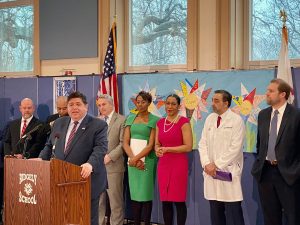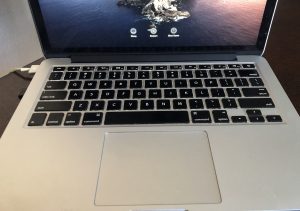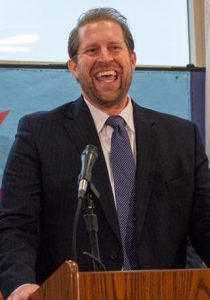Pandemic shines ‘great spotlight’ on digital divide
By Raymon Troncoso Capitol News Illinois — September 1, 2020
Gov. J.B. Pritzker speaks Wednesday, Feb. 5, at Ridgely Elementary School in Springfield to announce the release of the first phase of funding for a matching grant program to increase broadband internet access in the state. (Photo courtesy of @GovPritzker Twitter page)
SPRINGFIELD — Included in the $45 billion Rebuild Illinois capital infrastructure plan in 2019 was a $400 million investment aimed at providing statewide broadband access to every residence, business and community institution across the state by 2024.
“It’s an ambitious goal,” Matt Schmit, director of the Office of Broadband in the Department of Commerce and Economic Opportunity, said in an interview with Capitol News Illinois. “We think if we make smart investments, we think we can meet this goal, that’s why we put it in place and that’s why we want to push ourselves.”
The program, known as Connect Illinois, funds broadband expansion efforts through competitive grants that are matched with other nonstate dollars.
Advocates point out that the internet’s ubiquity in American life make connectivity essential for health care, education, and even management of finances.
But access to internet often has geographic or income boundaries, leaving swaths of land and its inhabitants cut off from the daily web necessities many take for granted.
The ‘digital divide’
In a 2018 report, the Federal Communications Commission found that around 10 percent of rural Americans lacked access to both fixed and wireless basic broadband, and that 31 percent had access to one but not the other. That’s not a measure of how many rural Americans have internet, but whether they even have the option to get it.
“That’s what they call the digital divide,” Lynden Schuyler, a director for census outreach at the Illinois Public Health Association, said.
Schuyler works as an intermediary for the Illinois Department of Human Services in the southern region of the state to encourage census participation. Despite Illinois having one of the highest self-response rates in the country at 69.5 percent as of Thursday, some rural counties in her region have struggled to break a 50-percent response rate. Two of the counties with the lowest rates – Alexander (44.7 percent) and Hardin (31.9 percent) – also struggle with internet access.
In an email to Capitol News Illinois in May, Schuyler wrote that 28 percent of approximately 1,400 households in Hardin County had no internet service and only 8 percent had a cellular data plan. In Alexander County, 51 percent of approximately 2,300 households lacked internet access, and just 17 percent had data plans.
Not having internet access creates problems as the U.S. Census Bureau emphasizes filing online this year. Nationally, more than half of census respondents have filled out their form on the internet, and the pandemic has limited and delayed door-to-door distribution of census forms.
Since census turnout is tied to federal funding, those challenges put millions of dollars in federal funding at risk across the state – the type of funding that could be used to improve insufficient broadband infrastructure and provide vital services in rural communities.
$1,400 per person undercounted
In a place like Sesser, Illinois, a city in Franklin County with a population that’s just under 2,000 people, each resident uncounted in the census can equal $1,400 lost per year, according to Mayor Jason Ashmore.

In a 2018 report, the Federal Communications Commission found that around 10 percent of rural Americans lacked access to both fixed and wireless basic broadband, and that 31 percent had access to one but not the other. (Photo by Judy Harvey/Chronicle Media)
“I mean just 20, 30 people and you’re talking tens of thousands of dollars we’ll lose each year,” Ashmore said. “We have a flood mitigation program that’s going on right now, we’re spending probably about $50,000. It wouldn’t take very many people to take out that $50,000.”
When rural communities such as Sesser are undercounted, they are unlikely to get an equitable return on their federal tax dollars compared to more urban ones, Ashmore said.
“This is just to bring back money we’ve already paid, and having a correct, accurate census count will make sure that we bring our fair share back to our community,” he said.
Ashmore said broadband connectivity is possible for everyone within the Sesser city limits, but rural residents within the same census bloc are probably closer to 50 percent lacking access entirely.
To combat situations where internet is not available either by cost or by access, the town provides a free Wi-Fi hotspot at the library, where residents can come in to fill out the census or park outside and do it from their vehicles.
Pandemic shines ‘great spotlight’
According to Schuyler, the dual crises of changing census guidelines and the COVID-19 pandemic have shined a “great spotlight” on the impact that lack of access to broadband has in rural communities.
“Access to education, access to jobs, it’s one of those areas where the whole partnership between business and government needs to happen, because it’s not going to be cheap,” she said.
The state awarded $50 million in broadband expansion grants through the Connect Illinois program in June. Due to the requirements set for obtaining Connect Illinois grants, that first batch of funding was matched by $65 million in nonstate funds for a total investment exceeding $115 million. Another $50 is slated for release later this year.
Barry Adair is CEO of the Wabash Telephone Co-op, based mainly in south-central Illinois. His company received about $1.6 million from Connect Illinois, which was then matched with nonstate funds, to complete a $3.2 million project bringing basic broadband to the small towns of Clay City and Sailor Springs.
Combined, the municipalities have a population of about 1,000. That means it costs about $3,200 per person to set down fixed lines providing what the FCC has benchmarked as basic broadband speed: 25mbps, or megabits per second.
The focus of Connect Illinois has been on scalable, fiber optic cables to provide broadband, rather than wireless networks such as 5G, which is used for internet in some cities. That means while each household on Connect Illinois broadband can receive internet at speeds of at least 25 mbps, once the lines are down to provide internet, they can be affordably scaled up to provide a gigabit, or 1000mbps.
“With fiber optics, you can guarantee every household is capable of getting a gig,” Adair said in an interview. “In cell towers you need to have them about every half mile to serve gigabit speeds.”
Discrepancies in Wi-Fi access were also noted in an Aug. 19 Illinois State Board of Education meeting regarding the choice between in-person and online learning.
Josh Quick, superintendent of the Robinson Community School District, said during that meeting that of the 1,600 students his district serves, 90 percent chose to return in-person to school, partly because of internet access.
Even if households had data plans, it didn’t make up for not having a fixed line connection.
“We’re here in southeast Illinois, and let’s just say the phone signals are not always reliable in this area,” he said.
Separate from the $400 million allocated for Connect Illinois, the Office of Broadband has also committed $20 million to the Illinois Century Network to repair and expand the state’s broadband for all K-12 schools in the state, a fiber optic cable network around 2,100 miles long.
‘One leg of the stool’

Matt Schmit, head of the office of broadband within the Illinois Department of Commerce and Economic Opportunity. (Capitol News Illinois photo by Jerry Nowicki)
According to Schmit of DCEO’s broadband office, before the coronavirus pandemic came to the U.S., Connect Illinois was already based on the premise that access to broadband was a pressing problem that needed to be addressed.
“Look at how the world has changed in the last several months, the urgency has only increased and we think we’re well positioned to make these long-term strategic investments on a progressive timeline,” he said.
Schmit said while some other states are using portions of federal revenues through the Coronavirus Aid, Relief, and Economic Security, or CARES, Act, to expand broadband, Illinois’ existing investment in that area allows the state to use the federal funds for other areas of immediate need.
“Because in Illinois we’ve got the Connect Illinois investment already on the table, our stakeholders, whether it’s at the State Board of Education or another state agency, are able to look at CARES Act funding and say ‘these dollars can be devoted solely to immediate need,’ and I think that speaks to the wisdom of our investment last year,” Schmit said.
Still, Schmit said access to broadband is just “one leg of the stool” when it comes to ensuring digital equity. The two other pillars of equity are broadband adoption – making sure people are using the internet once the groundwork is there – and broadband utilization – ensuring underserved communities can use it at the same level as their urban or higher-income peers.
“In my mind, if you look at it the right way, those are the components of a holistic approach to digital equity – how are you able to target resources and programming in a way that levels the playing field and makes sure that everybody has an opportunity to engage in the 21st century digital economy.”
rtroncoso@capitolnewsillinois.com







